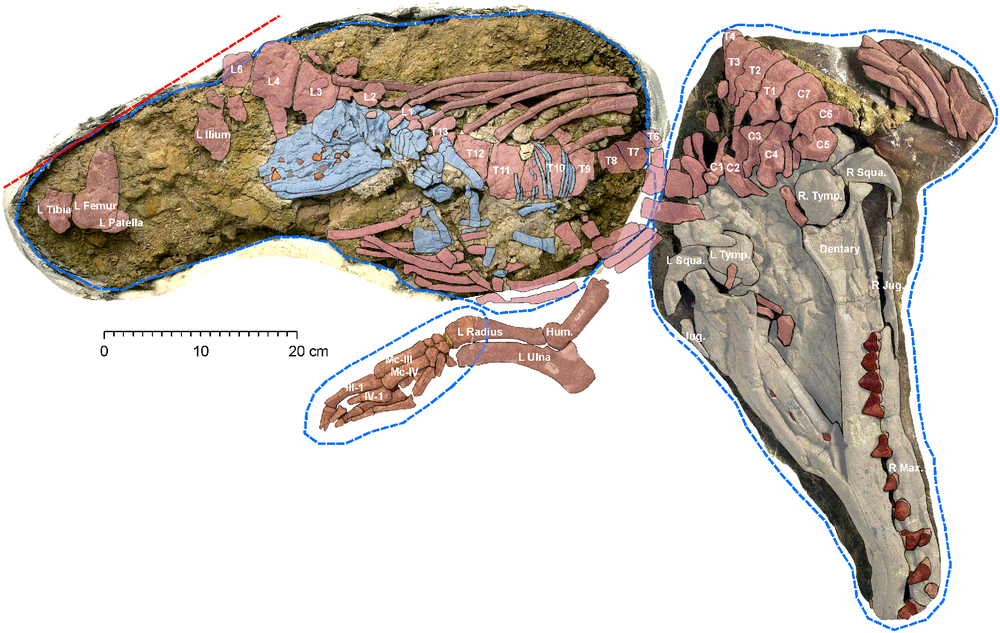![]() Transitionals are a hot topic in evolutionary biology because they provide clear evidence of common ancestry. In linking two seemingly unrelated groups in a shared genetic heritage one looks for evidence of organisms that display a moasic of characteristics, some characters defining one group and some another. Transitional forms are those organisms that display this mix of traits from two seemingly desperate groups. Contrary to denials of creationists transitionals are indeed found throughout the fossil record.
Transitionals are a hot topic in evolutionary biology because they provide clear evidence of common ancestry. In linking two seemingly unrelated groups in a shared genetic heritage one looks for evidence of organisms that display a moasic of characteristics, some characters defining one group and some another. Transitional forms are those organisms that display this mix of traits from two seemingly desperate groups. Contrary to denials of creationists transitionals are indeed found throughout the fossil record.
The evolutionary transition from land mammals to cetaceans (whales, porpoises and dolphins) is one of these well documented transitions. For many years the origin of whales was a mystery. Whales were obviously mammals but where they fit in the mammal family tree was unknown. Comparing the genes of cetaceans and other mammals lead to the conclusion that cetaceans arose from within a group of hoofed mammals called artiodactyls, but, this conclusion disagreed with the fossil evidence. This disagreement largely ended in 2001 when University of Michigan paleontologist Phillip Gingerich and colleagues published an account of new species of proto-whales from Pakistan, Artiocetus clavis and Rodhocetus balochistanensis. These fossils had skulls with the characteristic features of whales but unlike modern whales had hind limbs. But these early whales, protocetids, didn't just have any hind limbs but hind limbs with ankle bones only found in the artiodactyls, exactly as the genetic data predicted.
Gingerich and colleagues describe another protocetid from Pakistan in the journal Public Library of Science ONE. This new species of protocetid had four limbs but also exhibited features characteristic of a cetacean skull. Blue highlighted material is the skull and partial skeleton from a near-term fetus of Maiacetus inuus.These early cetaceans were predatory and amphibious, superficially similar to modern seals. One of the fossils carried with it a surprise that further linked these early cetaceans to their terrestrial mammal ancestors. The authors of this paper appropriately named this new species Maiacetus inuus, Maiacetus from the Greek Maia meaning mother and ketos meaning whale while the species name inuus refers to Inuus the Roman God of fertility. The name was appropriate because one of the specimens described by Gingerich and colleagues is associated by a fossilized, near-term fetus. The fetus was orientated consistent with a head-first birth as in modern land mammals and not in the tail-first found in modern whales and dolphins. These fossils suggested that despite all their cetacean characteristics protocetids gave birth on land and not in the water as in modern whales.
Blue highlighted material is the skull and partial skeleton from a near-term fetus of Maiacetus inuus.These early cetaceans were predatory and amphibious, superficially similar to modern seals. One of the fossils carried with it a surprise that further linked these early cetaceans to their terrestrial mammal ancestors. The authors of this paper appropriately named this new species Maiacetus inuus, Maiacetus from the Greek Maia meaning mother and ketos meaning whale while the species name inuus refers to Inuus the Roman God of fertility. The name was appropriate because one of the specimens described by Gingerich and colleagues is associated by a fossilized, near-term fetus. The fetus was orientated consistent with a head-first birth as in modern land mammals and not in the tail-first found in modern whales and dolphins. These fossils suggested that despite all their cetacean characteristics protocetids gave birth on land and not in the water as in modern whales.
The authors also found evidence of sexual dimorphism with a male fossil being approximately 12% longer than the female specimen. This size difference between males and females is not as great as in many modern whales but it is evidence that sexual dimorphism and maybe male-male competition for males appeared very early in whale evolution.
Whales continue to provide clear evidence of a transition between land mammals and whales. Molecular genetics and fossil evidence continue to point to whales arising from within hoofed mammals, the artiodactyls, and these new fossils further what we know about this key transition in mammalian history.
-END
Gingerich, P., Haq, M., Zalmout, I. S., Khan, I. H., & Malkani, M. S. (2001). Origin of Whales from Early Artiodactyls: Hands and Feet of Eocene Protocetidae from Pakistan Science, 293 (5538), 2239-2242 DOI: 10.1126/science.1063902
Gingerich, P., ul-Haq, M., von Koenigswald, W., Sanders, W., Smith, B., & Zalmout, I. (2009). New Protocetid Whale from the Middle Eocene of Pakistan: Birth on Land, Precocial Development, and Sexual Dimorphism PLoS ONE, 4 (2) DOI: 10.1371/journal.pone.0004366
